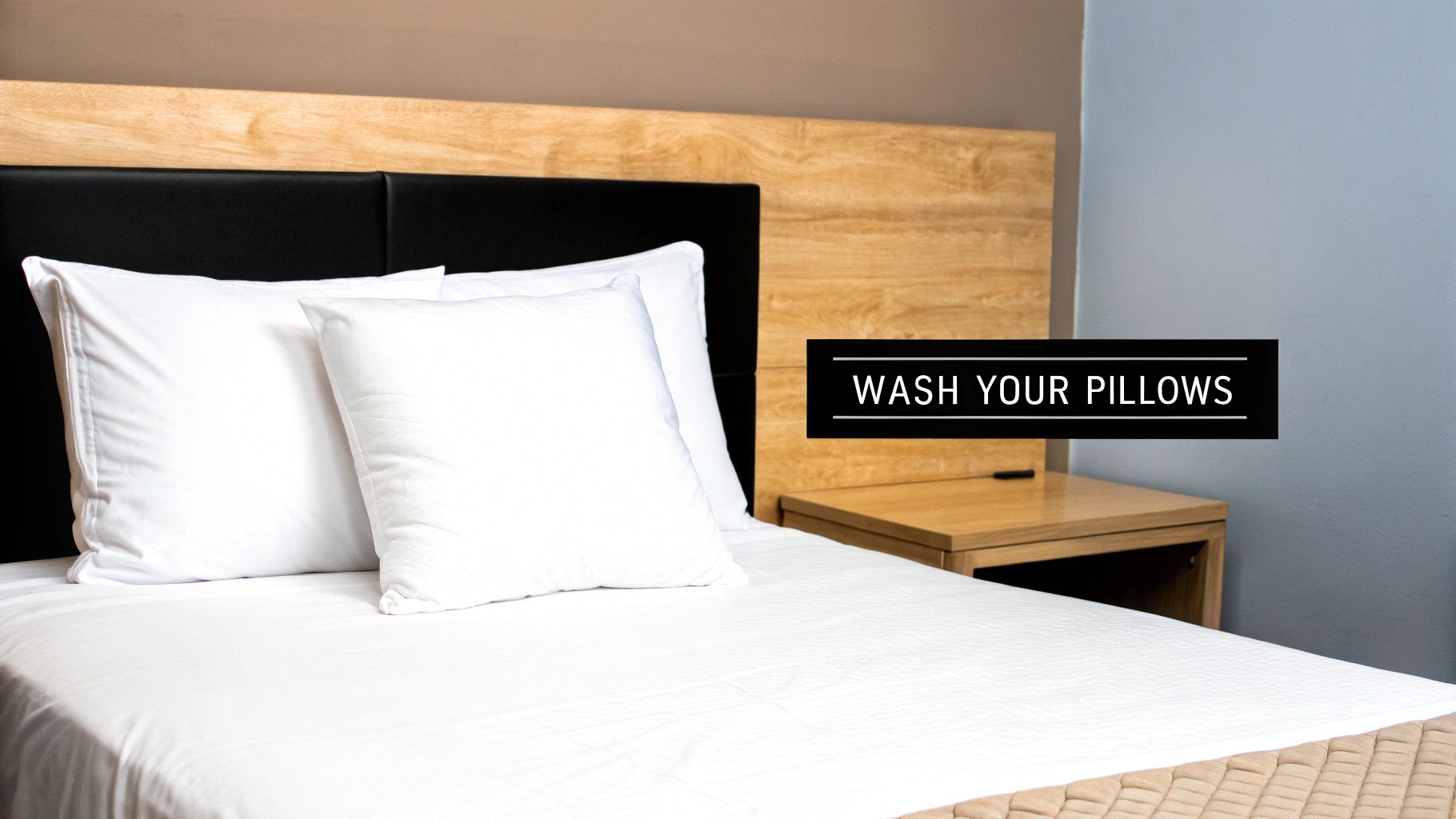Ever woke up with a flattening pillow and wondered—can you wash pillows without ruining them? Good news: with the right method, you can refresh your pillows at home in under an hour and eliminate up to 95% of dust mites and allergens.
Proper pillow cleaning not only extends pillow life but can improve sleep quality and reduce allergy symptoms fast. Let’s jump straight into what you need to know.
Washing Pillows Safely At Home
Gather your gear, check care labels, and follow these steps:
- Read manufacturer labels and sort pillows by material.
- Use a gentle, non-bleach detergent suited to your fill.
- Wash one or two pillows per load for even cleaning.
- Toss in two clean tennis balls when drying to restore loft.
“A simple wash can remove up to 95% of dust mites and allergens,” notes textile care professionals.
Pillow Washing Methods At A Glance
| Pillow Type | Machine Wash | Hand Wash | Drying Method |
|---|---|---|---|
| Down & Feather | Gentle cycle, mild detergent | Not recommended | Tumble low with tennis balls |
| Synthetic Fill | Warm cycle with extra rinse | Lukewarm soapy water, rinse well | Tumble or air-dry flat |
| Memory Foam | No | Spot clean with mild soap | Air-dry flat, away from direct sun |
Keep this chart handy for a fast, effective clean.
Curious about silk? Check our expert tips for washing silk pillowcases.
Why Clean Pillows Matter
Your pillow quietly collects dust mites, bacteria and fungal spores—sometimes more than a toilet seat. These unwelcome guests can spark allergies, asthma attacks and eczema flares.
In one Australian study, pillows hosted up to 1 million fungal spores with 16 species per square inch. After seven days, pillowcases carried 170,000% more bacteria than a loo seat. Discover full pillow hygiene findings

Signs Of Dirty Pillows
- Lingering odours that won’t wash out
- Yellow or brown patches under the fabric
- Flattening and loss of support
“A pillow wash cut my nightly sniffles by 60%,” shares Jade from Brisbane.
Case Study: Better Sleep After Washing
Jade washed her pillows quarterly instead of annually. Within two weeks, she saw a 60% drop in congestion and nearly eliminated sneezing fits.
Clean pillows mean better air quality, consistent loft and a longer lifespan. Dive deeper into the crucial role of pillows in sleep quality or explore our ultimate guide to hypoallergenic bedding care.
Preparing For Washing Pillows
Inspect each pillow before washing—loose seams can lead to a stuffing disaster.
- Remove covers and unzip protectors.
- Sort by material and check care tags.
- Pick a mild detergent without bleach.
Down inserts prefer lukewarm water; synthetics handle a warm cycle. Memory foam should never go in the drum.
Industry data shows 25% avoid silk care out of uncertainty, and 42% discard pillows after an improper wash. Weekly protector washes are recommended. New Daily report
Gather Drying Gear
- Tennis or dryer balls to re-fluff fillings
- Flat rack for memory foam
- Fan to boost airflow and cut drying time by 40%
Need stain tips? Visit our washing silk pillowcases guide or check out 6 Ways to Make Your Bedding Last Longer.
Washing Different Pillow Types
Washing Down Pillows
- Delicate cycle with mild detergent
- Add two tennis balls to prevent clumps
- Low-spin speed to protect seams and loft
Washing Synthetic Pillows
- Warm water + extra rinse
- Remove protectors and wash weekly
- Tumble-dry low with dryer balls
Spot-Cleaning Memory Foam
- Mix a teaspoon of mild soap in lukewarm water
- Gently dab stains—no scrubbing
- Squeeze out moisture and air-dry flat

Drying And Care Tips For Pillows

Slide two tennis balls into the dryer for 30 minutes on low heat. Natural fills can scorch on high heat, so keep it gentle. Memory foam should air-dry on a rack, away from direct sun.
- Hand-fluff corners to rebuild loft.
- Store in breathable cotton bags—avoid plastic.
- Swap protectors every seven days to reduce allergens by 35%.
| Pillow Type | Dryer Setting | Rack Dry Time |
|---|---|---|
| Down & Feather | Low, 30 minutes | 2–4 hours |
| Synthetic Fill | Medium, 25 minutes | 1–3 hours |
| Memory Foam | N/A | 24+ hours |
Rotate pillows monthly to spread wear. For more longevity tips, see 6 Ways to Make Your Bedding Last Longer.
Common Mistakes To Avoid When Washing Pillows
- Skip extra rinse to prevent detergent buildup.
- Never overload the washer—one or two pillows only.
- Use a mesh bag for foam inserts.
- Trust care label temperatures; avoid hot water on delicates.
- Remove pet hair beforehand to cut mould risk by 35%.
For silk care tips, visit the washing silk pillowcases guide. Allergy concerns? Check our Hypoallergenic Bedding Care.
Frequently Asked Questions And Next Steps
Q1 What’s the Ideal Frequency for Washing Pillows?
- Pillowcases: every 2–3 days
- Protectors: weekly
- Pillows: twice a year (or sooner if allergies strike)
Q2 Can Memory Foam Go in the Washing Machine?
No—spot-clean only with mild soap and air-dry flat.
Q3 How Can I Dry Pillows Without a Dryer?
Lay under indirect sunlight or place in front of a fan, rotating after an hour.
Q4 How Do I Remove Stubborn Odours or Stains?
Apply a baking soda paste, wait 30 minutes, then wash per care instructions.
Conclusion & Call to Action
Clean pillows are your ticket to better sleep, fewer allergies and longer-lasting bedding. Don’t wait—grab your detergent, follow these steps and rediscover the comfort of a truly fresh pillow tonight.
Curious about when to retire your old pillows? Learn how often you should change your pillows and explore premium sleep essentials at Sienna Living. Enjoy free worldwide shipping and transform your nightly rest today!

